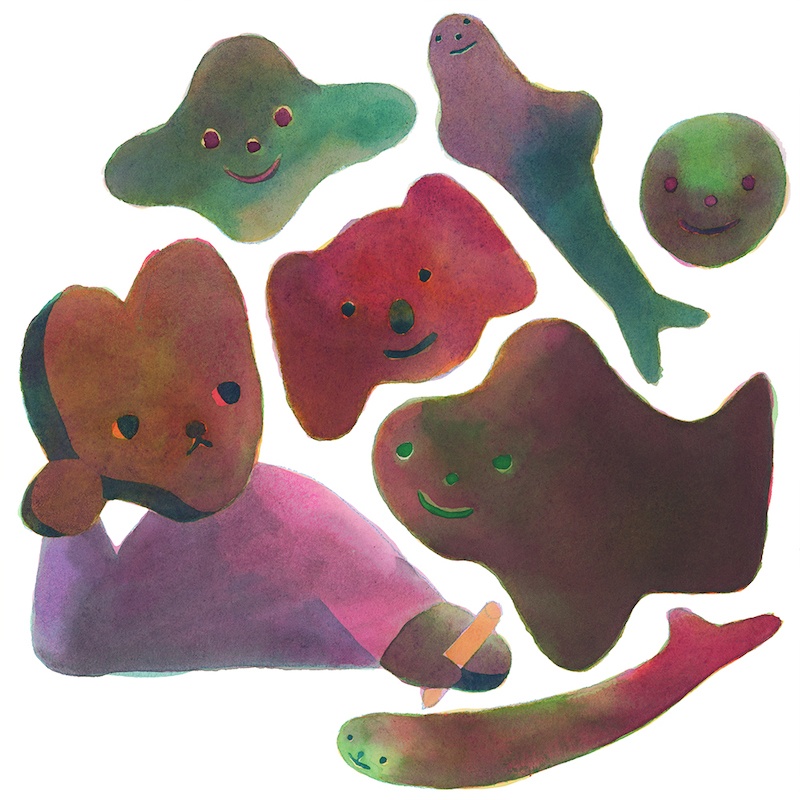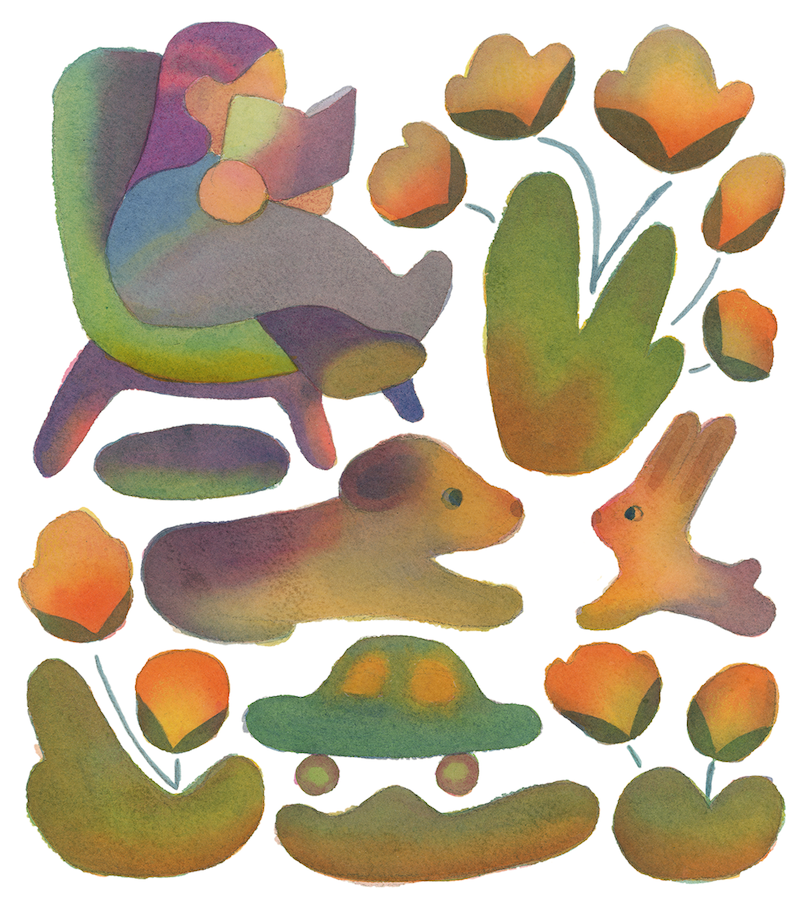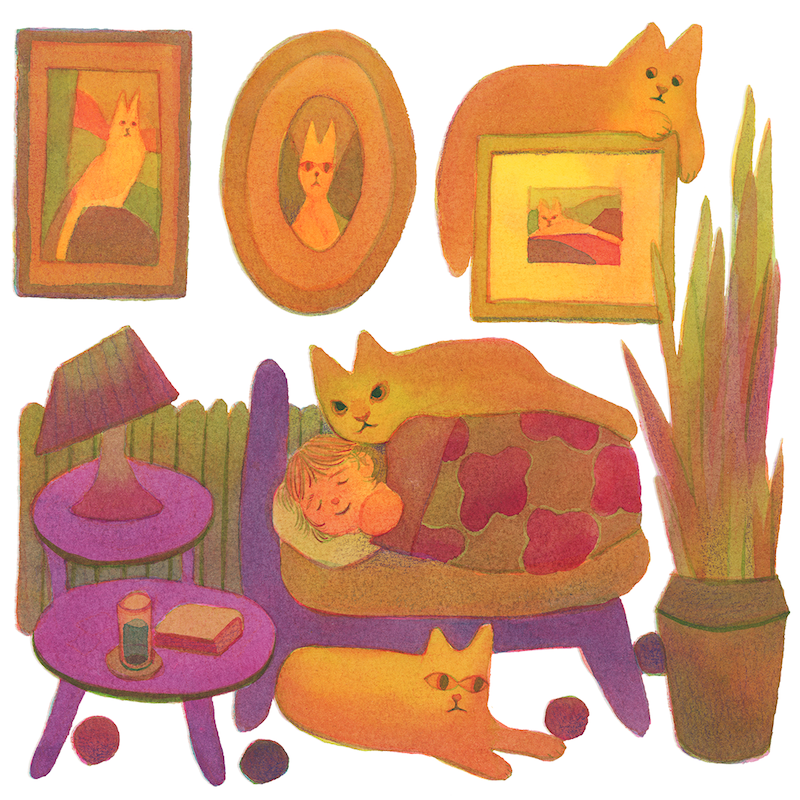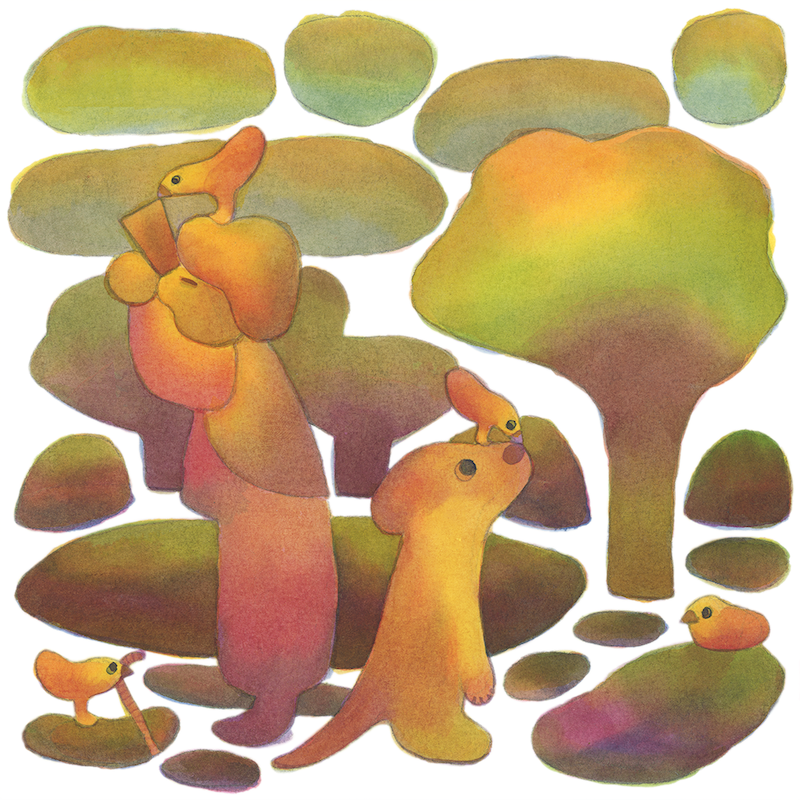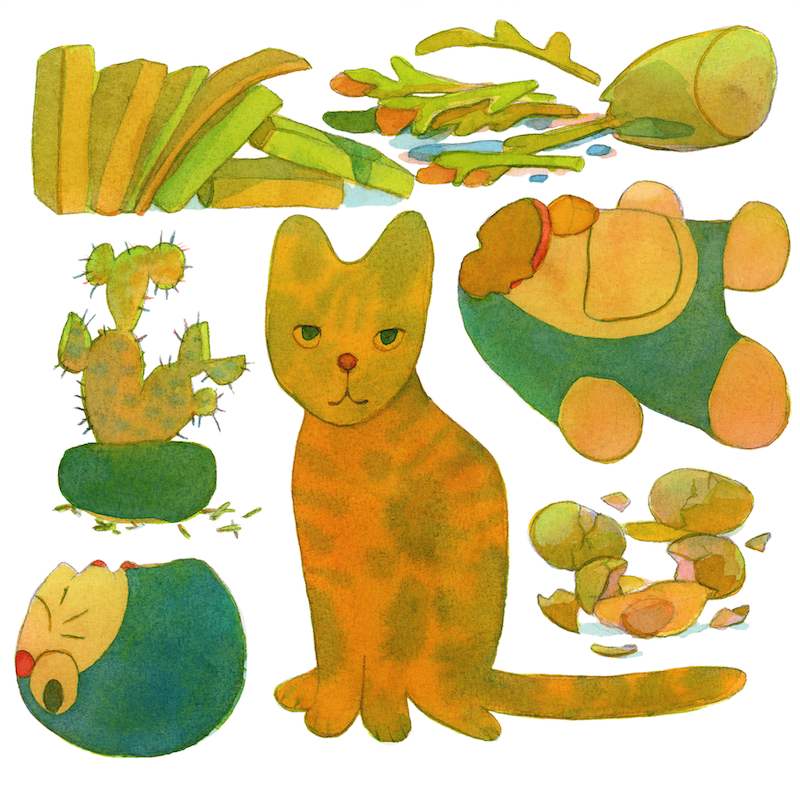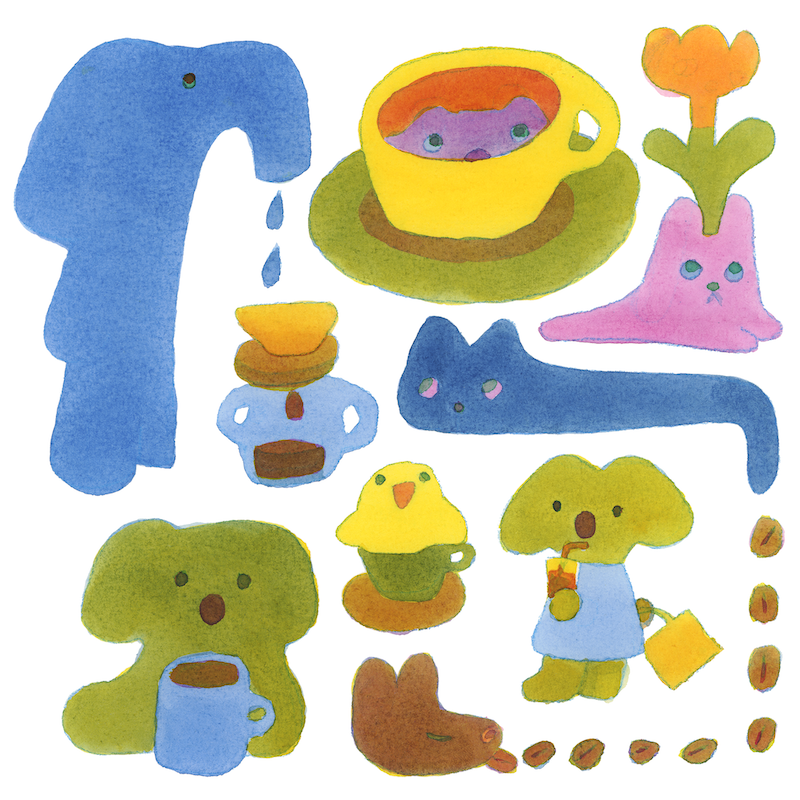I get a sense of childlike wonder but also an undercurrent of longing and melancholy from your work. I was wondering if you could tell me a little bit about those elements and the tension between them.
I really gravitate towards softness overall, just as a person and what I want to put out into the world… I feel like a lot of books that I remember from my childhood, that I still think of, the imagery was printed in this way where [the] colors were really vibrant, but then also, because they’re so mass produced … I don’t really know what the process is called, but they sometimes get blurred.
In the end it just really comes down to however I’m having fun with the drawing, and the sense that the softness comes out from the texture that I’m putting down on the paper. And pushing that piece in the direction of like, “Yeah, I want this to be cute, but also dreamy.”
Sometimes I get wrapped up in “this doesn’t feel like a high concept piece,” but then that feels okay to me. I feel like I am still being true to myself in that general “putting nice things into the world” kind of thing.
I think it’s interesting that I’m also picking up some melancholy because the way you talk about your art comes back to softness. I wonder if that’s something that has come up before.
Oh yeah, definitely in other artists that I like. Growing up and looking at artists that are like Yoshitomo Nara, who is a painter who does paintings and drawings of faces [that] have a lot of attitude, but there’s also a general sense of alone-ness and alienation. And maybe it has to do with a certain generation of art. I definitely look at this art less now that I’m in my 30s, but through my teens all the way to 25, I would love a painting with like, a kid with a nosebleed. That visual of being alone—but that [concept] being drawn in a very interesting way.
You’ve described your aesthetic as undulating, blended colors. How did you arrive at this specific style? Did your work always look like it does today?
No. For a long time I actually didn’t really have a lot of experience with using color. I just wasn’t trained. For a long time I would just draw. I would just use [a] pen and maybe the odd marker, but I didn’t actually think about putting colors down in a way that made sense for composition until I wanted to apply to art school. I wouldn’t think about color until I had to finish a piece instead of just drawing a lot in sketchbooks and stuff like that.
It kind of feels like painting where you’re laying down a base sketch and then building color on top of it. I really liked oil painting, but I had a lot of trouble getting better at it. And I just had a lot of trouble with the setup too. It’s a lot of setup, it’s a lot of material. It’s quite toxic. Pencil crayons were just so much more accessible, and the process of layering each color is really meditative. And I got good feedback. I just kept doing it and hopefully I can keep changing it up a little bit. I got to it through experimentation, but also applying tried and true methods of layering colors.
So what are the main tools or mediums that you’re interested in right now?
I’ve always worked a part-time job or a full-time job. So even though I really like the idea of having a setup and just going at it over [a few] days, I find that mediums that are easy to pick up and put down, like pencil crayons, [are] just easier to get into. You just take it up and you start putting stuff down. I also really like watercolor, specifically water soluble inks—they’re concentrated watercolors that are liquid. I started using [those] recently in a similar way to the pencil crayon stuff where I’m taking layers and layers and building them up… It’s funny that the medium ends up being what works with the way that I make art, which is just that I want to be able to pick up something fast.
Do you get any sort of inspiration or creative exchange between your jobs and the art you make?
I’ve worked as a barista through art school and the whole time after I graduated. Being in a service job… I don’t love it sometimes, of course. You’re dealing with people of all different kinds of moods, but when there is a great interaction or you see something really cute happening, like people with strollers and their kid is just having a great time… I find those moments align with the feeling that I want my work to have. I enjoy finding these moments at my job and not necessarily illustrating it, but drawing energy from that.
What are the ways that you balance having part-time/full-time work and making your art?
I’ve had part-time jobs for a very long time because I thought that I needed more time to focus—to have [time] for art so that when I do get jobs and I do have projects to work on, then that time is there.
And what ends up happening is I’ll have spurts of work and productivity. But I learned from the way I work—from noticing what I actually do versus what I’m trying to plan to do—that I’m not somebody who is great at like, finishing a comic in one month from beginning to end. I was always under this impression that like, graphic novelists just take a year off and finish the entire thing from the beginning to the end, and that’s just how you do it. I don’t work like that. I actually work a lot better with slower schedules and more consistent practice… Now that I have a full-time job, I do a little bit of drawing every day and plan my projects way in advance and just do the work a little bit sometimes on the days that I work. Some other times I just do one day a week. So I’m working five days a week. I dedicate one day to going to my studio and working on something there, and then one other day to do chores and stuff like that. So far it’s felt a lot more sustainable to me.
I do think that sometimes there’s a pressure to feel like you have to do things a certain way, or maybe you know a lot about how an artist that you really like does things in terms of process. But if that doesn’t work out for you, it doesn’t mean it’s the wrong way to do it.
Yeah. I definitely, for a very long time, have been like: “I need to be an artist by being a full-time artist, being in the studio for 10 hours a day.” Whereas most days I’m not actually doing anything. Also, I live with my partner and he is very helpful in pointing [out] my habits and the way I tend to work out to me, as well as helping me stay on track. He has been a great help in me trying to figure out what works for me and sticking to that.
I was reading about Wavering Line Collective and thinking about collaboration being an element that could be part of someone’s artistic process. Is collaboration something that you’re still really interested in?
Unfortunately I don’t have as much of it now. I mean, [the] pandemic has stopped a lot of gatherings, but this year has been a lot more social stuff for me. I share a studio now with my collective members. So even though we haven’t necessarily released anything, I think having that space of working in there and just being able to poke your head over and be like, “How does this look?” Or, “I don’t like this part of it. Does this bother you as well?” That’s super essential to me, [it’s] just really helpful to have a second person you trust and whose aesthetic you know.
I also work with an organization called Story Planet. They do creative storytelling and arts workshops with a lot of kids in schools in Toronto. I work sometimes as a workshop facilitator and an artist with them. That means I get to draw with kids. Sometimes kids watch me draw. It’s mostly been online so far, unfortunately I don’t get to work on the same drawing as another artist or the kids in the workshops. I really enjoy the ideas that happen in collaborating when you’re creating a thing together.
For example, in the workshops that we run, there is one called “character maker.” You present this idea of creating a character to these kids. Usually we come up with one main idea. There will be different artists for different groups in the whole class. And each artist will create a family member of this family of characters. So I am drawing for them when they come up with their ideas. As an artist, I also have ideas of how I want the drawing to go. It’s really fun and I get ideas or input that’s completely different from a character that I’m envisioning. It’s not like this is a character that I made, it’s a character that we’ve all made together. It’s interesting how one idea can be approached very differently. It’s also super fun connecting with kids in that way.
In hearing you talk about collaborating and learning from kids, what are your suggestions for artists to bring just a little bit more whimsy or more lightness into their own work?
I like silly things. So when I’m trying to do something funny, I’ll just leave it at silly, and try not to think more about it. There’s a quote by John Waters—just a disclaimer I don’t know very much about John Waters, this is a picture on Tumblr—“Sometimes stupid and cute are enough.” That quote is like, “Yeah it really is just enough!” My dumb drawing of a pair of mittens next to a similarly-shaped thing that I just labeled gingerbread man in a Speedo doesn’t need to be more than that. Just keeping it simple. Sometimes I overthink my humor and that doesn’t work. That’s when it stops working. Even in real life when I’m trying to make a joke about something and I’m three steps ahead. And of course no one else gets it.
It’s like knowing our brains will steer us into overthinking and we can’t really stop that. But just acknowleding that and saying ‘Okay, I know where this is going to go but I’m going to try and curb it a little.’
Yeah. I feel like a lot of whimsical stuff, to me, doesn’t seem to be created with the idea of whimsy. But what gives it whimsy is the simplicity and directness of the message or the design. A lot of kids’ stuff has a lot of whimsy. It’s so simple, it’s so clear.
Do you feel like your process is really different or maybe you consciously have to put yourself into a different mindset when you make editorial illustrations?
It’s really different. I don’t have a ton of experience with editorial jobs. I overthink it from the beginning. So the way that I usually work is I’ll get the job, I’ll overthink all of my sketches, and then at some point have to pull back… It’s kind of like when you do a mind map or you do a lot of journaling or writing or drawing to get all of the garbage out before the better ideas come up. With editorial and quote unquote “professional illustration jobs” I have to do a lot of that, unfortunately. There’s a lot of clearing out of what I don’t think are good ideas or ideas that are not me. I have to get past that idea. Or I have to get past those ideas before I find something that’s like, “Okay, this is a kind of idea and image that I do, and this is why I was hired.”
Whereas with my own stuff, there’s no pressure…There’s a big part of me that thinks that I’m not a real artist because I don’t do it full-time, which isn’t true. So I hope [that] me talking about my process with figuring out how to do my art better— in a way that suits me with my full-time job with all my other stuff that I need to do—helps, I guess, reassure people reading who might be creative and have jobs that pay the bills. It’s super, super, super common.
I forget all the time that there’s a ton of creatives who have one full-time job, two full-time jobs…Sometimes I just stop painting or drawing for, I don’t know, two weeks, just because I don’t feel like it. I know that’s totally okay.
Lis Xu Recommends:
Fresh Pepper, by Joseph Shabason and André Ethier
Fei Zi Xiao Lychees
Small and light, insignificantly sized sketchbooks
Fair Play, by Tove Jansson
Scout Is Not A Band Kid, by Jade Armstrong
This content originally appeared on The Creative Independent and was authored by Eva Recinos.
Eva Recinos | Radio Free (2022-07-19T07:00:00+00:00) Artist Lis Xu on balancing your creative work and your day job. Retrieved from https://www.radiofree.org/2022/07/19/artist-lis-xu-on-balancing-your-creative-work-and-your-day-job/
Please log in to upload a file.
There are no updates yet.
Click the Upload button above to add an update.
